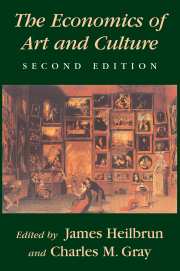Book contents
- Frontmatter
- Contents
- List of figures and tables
- Preface
- Part I The arts sector: Size, growth, and audiences
- Part II The microeconomics of demand and supply
- 4 Consumer demand: An introduction
- 5 The characteristics of arts demand and their policy implications
- 6 Production in the performing arts
- 7 Firms and markets in the performing arts
- 8 Productivity lag and the financial problem of the arts
- Part III The fine arts and museums
- Part IV Public policy toward the arts
- Part V Art, economy, and society
- Index
4 - Consumer demand: An introduction
Published online by Cambridge University Press: 05 September 2012
- Frontmatter
- Contents
- List of figures and tables
- Preface
- Part I The arts sector: Size, growth, and audiences
- Part II The microeconomics of demand and supply
- 4 Consumer demand: An introduction
- 5 The characteristics of arts demand and their policy implications
- 6 Production in the performing arts
- 7 Firms and markets in the performing arts
- 8 Productivity lag and the financial problem of the arts
- Part III The fine arts and museums
- Part IV Public policy toward the arts
- Part V Art, economy, and society
- Index
Summary
In Chapter 2 we described the growth of the audience for the arts and in Chapter 3 its size and character. It should be intuitively clear that its size, character, and rate of growth over time depend importantly on consumer behavior in the marketplace. Some consumers enjoy the arts enough to spend time and money on them. They make up the audience. Others, who differ in some way from the first group, do not enjoy them enough to become arts consumers. Are the same factors at work in both cases? What are they? We turn next to a systematic analysis of consumer choice and of what economists call consumer demand.
A number of assumptions underlie the economic analysis of consumer choice. First, because their incomes are limited, consumers cannot afford to satisfy all their material desires. They must therefore choose among the many possible objects of consumption. Second, these choices are made rationally. Consumers try to spend their income in such a way as to get the greatest possible total satisfaction from it. Economists use the term “utility” in place of “satisfaction,” so in the jargon of economics, consumers behave as “utility maximizers.” Finally, individual commodities are subject to the “law of diminishing marginal utility,” to which we now turn.
MEASURING THE UTILITY OF CONSUMPTION
Propositions about utility are most easily explained if we suppose that the buyer can actually measure the satisfaction obtained from each act of consumption in terms of units of utility.
- Type
- Chapter
- Information
- The Economics of Art and Culture , pp. 61 - 84Publisher: Cambridge University PressPrint publication year: 2001



